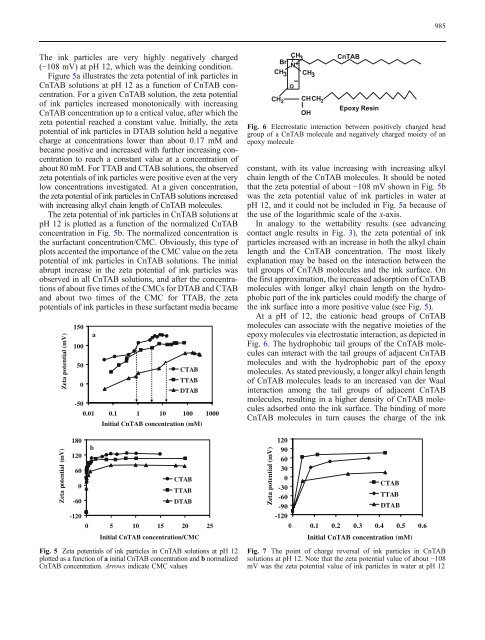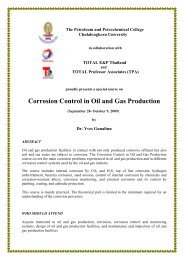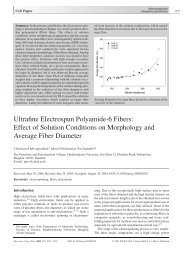Removal of solvent-based ink from printed surface of HDPE bottles ...
Removal of solvent-based ink from printed surface of HDPE bottles ...
Removal of solvent-based ink from printed surface of HDPE bottles ...
Create successful ePaper yourself
Turn your PDF publications into a flip-book with our unique Google optimized e-Paper software.
The <strong>ink</strong> particles are very highly negatively charged<br />
(−108 mV) at pH 12, which was the de<strong>ink</strong>ing condition.<br />
Figure 5a illustrates the zeta potential <strong>of</strong> <strong>ink</strong> particles in<br />
CnTAB solutions at pH 12 as a function <strong>of</strong> CnTAB concentration.<br />
For a given CnTAB solution, the zeta potential<br />
<strong>of</strong> <strong>ink</strong> particles increased monotonically with increasing<br />
CnTAB concentration up to a critical value, after which the<br />
zeta potential reached a constant value. Initially, the zeta<br />
potential <strong>of</strong> <strong>ink</strong> particles in DTAB solution held a negative<br />
charge at concentrations lower than about 0.17 mM and<br />
became positive and increased with further increasing concentration<br />
to reach a constant value at a concentration <strong>of</strong><br />
about 80 mM. For TTAB and CTAB solutions, the observed<br />
zeta potentials <strong>of</strong> <strong>ink</strong> particles were positive even at the very<br />
low concentrations investigated. At a given concentration,<br />
the zeta potential <strong>of</strong> <strong>ink</strong> particles in CnTAB solutions increased<br />
with increasing alkyl chain length <strong>of</strong> CnTAB molecules.<br />
The zeta potential <strong>of</strong> <strong>ink</strong> particles in CnTAB solutions at<br />
pH 12 is plotted as a function <strong>of</strong> the normalized CnTAB<br />
concentration in Fig. 5b. The normalized concentration is<br />
the surfactant concentration/CMC. Obviously, this type <strong>of</strong><br />
plots accented the importance <strong>of</strong> the CMC value on the zeta<br />
potential <strong>of</strong> <strong>ink</strong> particles in CnTAB solutions. The initial<br />
abrupt increase in the zeta potential <strong>of</strong> <strong>ink</strong> particles was<br />
observed in all CnTAB solutions, and after the concentrations<br />
<strong>of</strong> about five times <strong>of</strong> the CMCs for DTAB and CTAB<br />
and about two times <strong>of</strong> the CMC for TTAB, the zeta<br />
potentials <strong>of</strong> <strong>ink</strong> particles in these surfactant media became<br />
Zeta potential (mV)<br />
Zeta potential (mV)<br />
150<br />
100<br />
50<br />
0<br />
-50<br />
180<br />
120<br />
60<br />
0<br />
-60<br />
-120<br />
a<br />
CTAB<br />
TTAB<br />
DTAB<br />
0.01 0.1 1 10 100 1000<br />
b<br />
Initial CnTAB concentration (mM)<br />
CTAB<br />
TTAB<br />
DTAB<br />
0 5 10 15 20 25<br />
Initial CnTAB concentration/CMC<br />
Fig. 5 Zeta potentials <strong>of</strong> <strong>ink</strong> particles in CnTAB solutions at pH 12<br />
plotted as a function <strong>of</strong> a initial CnTAB concentration and b normalized<br />
CnTAB concentration. Arrows indicate CMC values<br />
CH<br />
3<br />
Br<br />
N+<br />
CH3 CH3 -<br />
CH 2<br />
O<br />
CH CH 2<br />
OH<br />
CnTAB<br />
Epoxy Resin<br />
Fig. 6 Electrostatic interaction between positively charged head<br />
group <strong>of</strong> a CnTAB molecule and negatively charged moiety <strong>of</strong> an<br />
epoxy molecule<br />
constant, with its value increasing with increasing alkyl<br />
chain length <strong>of</strong> the CnTAB molecules. It should be noted<br />
that the zeta potential <strong>of</strong> about −108 mV shown in Fig. 5b<br />
was the zeta potential value <strong>of</strong> <strong>ink</strong> particles in water at<br />
pH 12, and it could not be included in Fig. 5a because <strong>of</strong><br />
the use <strong>of</strong> the logarithmic scale <strong>of</strong> the x-axis.<br />
In analogy to the wettability results (see advancing<br />
contact angle results in Fig. 3), the zeta potential <strong>of</strong> <strong>ink</strong><br />
particles increased with an increase in both the alkyl chain<br />
length and the CnTAB concentration. The most likely<br />
explanation may be <strong>based</strong> on the interaction between the<br />
tail groups <strong>of</strong> CnTAB molecules and the <strong>ink</strong> <strong>surface</strong>. On<br />
the first approximation, the increased adsorption <strong>of</strong> CnTAB<br />
molecules with longer alkyl chain length on the hydrophobic<br />
part <strong>of</strong> the <strong>ink</strong> particles could modify the charge <strong>of</strong><br />
the <strong>ink</strong> <strong>surface</strong> into a more positive value (see Fig. 5).<br />
At a pH <strong>of</strong> 12, the cationic head groups <strong>of</strong> CnTAB<br />
molecules can associate with the negative moieties <strong>of</strong> the<br />
epoxy molecules via electrostatic interaction, as depicted in<br />
Fig. 6. The hydrophobic tail groups <strong>of</strong> the CnTAB molecules<br />
can interact with the tail groups <strong>of</strong> adjacent CnTAB<br />
molecules and with the hydrophobic part <strong>of</strong> the epoxy<br />
molecules. As stated previously, a longer alkyl chain length<br />
<strong>of</strong> CnTAB molecules leads to an increased van der Waal<br />
interaction among the tail groups <strong>of</strong> adjacent CnTAB<br />
molecules, resulting in a higher density <strong>of</strong> CnTAB molecules<br />
adsorbed onto the <strong>ink</strong> <strong>surface</strong>. The binding <strong>of</strong> more<br />
CnTAB molecules in turn causes the charge <strong>of</strong> the <strong>ink</strong><br />
Zeta potential (mV)<br />
120<br />
90<br />
60<br />
30<br />
0<br />
-30<br />
-60<br />
CTAB<br />
TTAB<br />
-90<br />
-120<br />
DTAB<br />
0.0 0.1 0.2 0.3 0.4 0.5 0.6<br />
Initial CnTAB concentration (mM)<br />
985<br />
Fig. 7 The point <strong>of</strong> charge reversal <strong>of</strong> <strong>ink</strong> particles in CnTAB<br />
solutions at pH 12. Note that the zeta potential value <strong>of</strong> about −108<br />
mV was the zeta potential value <strong>of</strong> <strong>ink</strong> particles in water at pH 12





